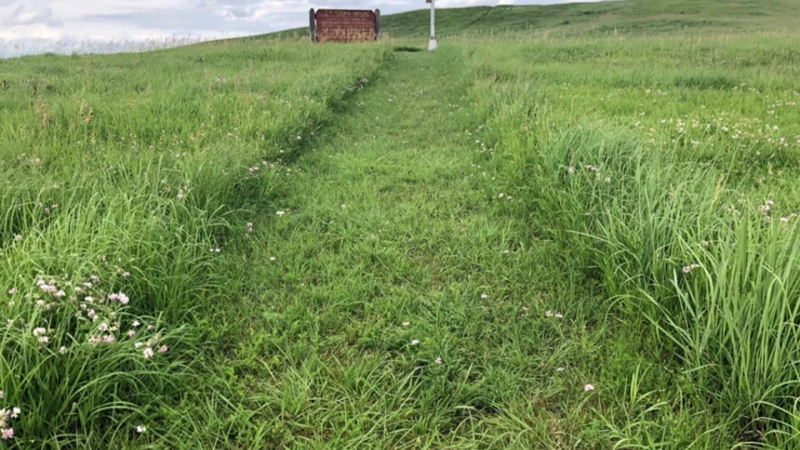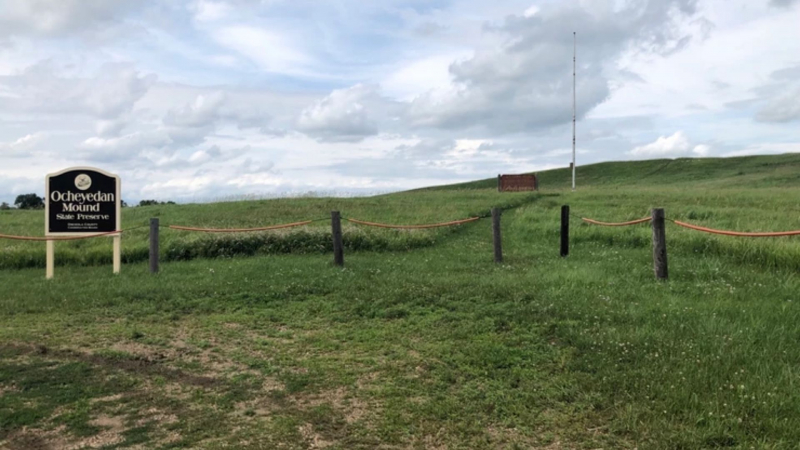Ocheyedan Mound

Few natural objects in Iowa have sparked as much interest as the Ocheyedan Mound in northwest Iowa's lakes region. The Mound, located about southeast of the village of Ocheyedan, rises 170 feet above the surrounding flood plain. It is one of Iowa's highest points, standing at 1655 feet above sea level, only 15 feet lower than Hawkeye Point, the state's highest point. The Mound is about two miles south of Highway 9 and is easily accessible to visitors through a concrete and blacktop road.
The Ocheyedan Mound is one of the most picturesque hills in the state's northwest, with its form visible for kilometers in all directions. Rolling hills characterize the region around the Ocheyedan River flood valley. Some are in groups, each with a unique layout. Others are fairly isolated, with the Mound being the most obvious example.
The Mound's general trend is northeast and southwest. It is barely about a third of a mile long at its longest. Its small top is only a few yards broad at places.
The Mound was long assumed to be an Indian burial place. When geologists examined, they discovered that it was a kame of glacial origin. Kames are stratified drift hills and ridges deposited by glaciers near the mouths of ice tunnels or ice channels, as well as at ice angles. The Mound was constructed roughly 13,000 years ago with the retreat of the Wisconsin ice sheet, the last glacier to enter Iowa. The Mound's composition is primarily sand and gravel, with tiny boulders of varying sizes and rocks of diverse sorts. Granites, Sioux quartzite, and limestone are all available.
Local people should cherish the esthetic worth of such beautiful and intriguing geological occurrences as the Ocheyedan Mound, and every effort should be taken to avoid their destruction. Already, the Ocheyedan Mound has been tainted by the removal of sand and stones from its peak for commercial uses. To be sure, the Mound is important for the many tons of material that could be extracted from it, but it is far more valuable to the state as a beauty place, a monument that should be preserved for future generations with the same enthusiasm that they should preserve their material treasures.
It's unclear where the name Ocheyedan comes from. Acheya and Akicheya, both meaning to weep for a deceased relative, appeared in an early Dacotah (Sioux) dictionary produced in 1852. The Indians of the region used them to honor two Indian lads who were slain here by a group of tribe foes. Acheya (called Ocheyedan by European settlers) is a place of grief. Nobles County's (Minnesota) biggest lake was known as Ocheyeda. The town in Osceola County was renamed "Ocheyedan" when a "n" was added.
According to legend, the Indians utilized the Mound as an observation point and a place of grief. It was utilized as a guide through the plains by white men, and it is now popular for picnics, steak fries, fireworks displays, and winter sliding, toboggan parties, and skiing.
The Burlington, Cedar Rapids and Northern Railroad, today known as the Chicago, Rock Island and Pacific, passed through Osceola County in the summer of 1884. The arrival of the railroad was a big deal on the prairie and in this sparsely inhabited region—one of the last in Iowa to be colonized.
In the fall of 1884, construction efforts began, and the prairie town of Ocheyedan was a hive of activity, with every available person engaged in some form of labor. The first structure built on the town site was a shanty, also known as a shack. That year, the post office was relocated to the town site from Rush Lake, where it had resided since 1875. Rush Lake, located a mile northeast of town, is well-known for its superb waterfowl hunting.
Ocheyedan, like many tiny Iowa communities, has seen its population decline over the years. It today has a population of just 545 people, but it has been recognized by the state betterment committee for several initiatives of improvement in business, housing, retirement, recreation, churches, schools, and other fields.
The Tracy House Museum, also in Ocheyedan, houses objects contributed by the community that predate 1902. Dishes, a table, and a Bible from the Congregational Church are among the goods. The Osceola County Historical Society got interested in saving the home in 1976. Aside from the home, there is a steel structure that houses vintage farming instruments, ancient office machinery, county documents, books, pictures, and trophies.
The Ocheyedan Pits Recreation Area is two miles south of Ocheyedan and has a picnic shelter, bathrooms, water, camping, fishing, swimming, and nature paths on its 33-acre property. Electricity, drinking water, pit toilets, picnics, hiking, fishing, and swimming are all available at the park.
The Willow Creek Wildlife Management Area, located 5 miles west of Ocheyedan on Highway 9, is home to the Osceola County Conservation office. There's a resort, a nature center, and a classroom here. A 3.5-acre lake, natural and restored grassland, and chances for fishing, hunting, hiking, birdwatching, nature research, and photography are all available in the vicinity. For varied events, the lodge can accommodate up to 55 persons.
County: Osceola
Elevation: 1,655 ft




